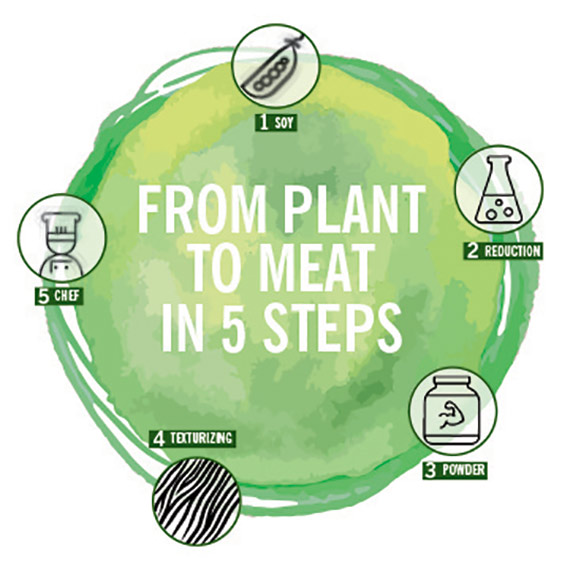Lab to table
 1. SOY: Most commercially available plant-based meat alternatives start as soybeans.
1. SOY: Most commercially available plant-based meat alternatives start as soybeans.
2. REDUCTION: Harvested soybeans undergo a chemical de-fattening process to isolate protein by removing soy oil.
3. POWDER: Soy isolate is reduced to powder, like the kind commonly found in vegan protein shakes. Protein is a critical part of meat, but studying other components, such as fat and collagen, helps researchers reverse-engineer the flavor and texture of cooked meat.
4. TEXTURIXING: Animal protein comes from muscle and is organized in straight lines. Plant protein, like soy, is erratically shaped. A mechanical extruder is used to make plant protein fibers behave more like animal protein — a crucial, difficult step that may vary from stock to stock.
5. CHEF: The resulting plant-based meat product looks like manicured chicken strips. To best mimic meat, the flavor and texture should be artfully prepared.Making a plant-based substitute to replace energy- and resource-intensive factory-farmed meat is among the latest challenges taken up by the Sutardja Center for Entrepreneurship and Technology (SCET). This semester, 45 students are studying the market dynamics of plant-based protein and trying to create vegetarian options that look, feel and taste like real meat but are more environmentally sustainable.
Factory-farmed meat accounts for about a quarter of global carbon emissions, according to the Good Food Institute, a nonprofit organization based in Washington, D.C. that is partnering with SCET on the course.
“Some of the students enrolled because they are convinced that this is urgently needed,” says Ricardo San Martin, visiting SCET faculty member, course instructor and entrepreneur. “But all of them share a desire for impact — to be a force in the world.”
The course is part of the center’s Challenge Lab series and is formatted like an incubator: Teams design a product and pitch it to a panel of experts in hopes of winning prize money to form a company.

